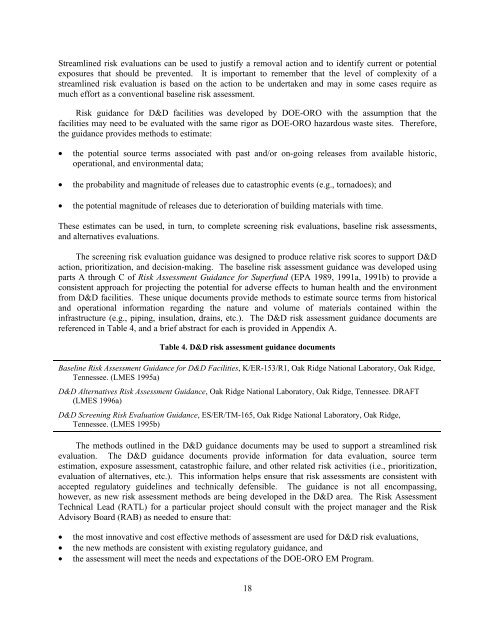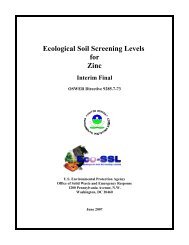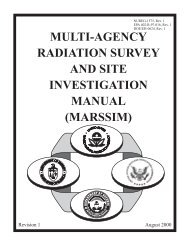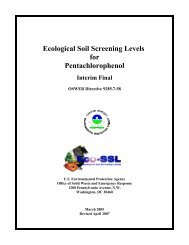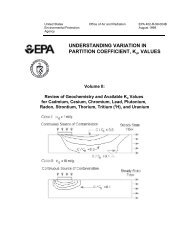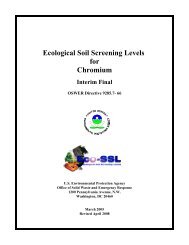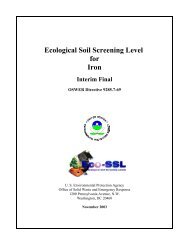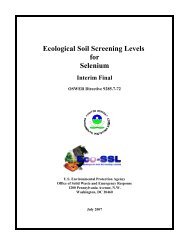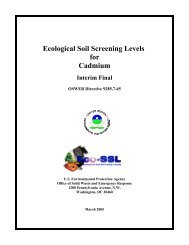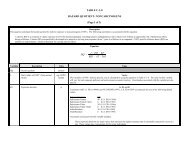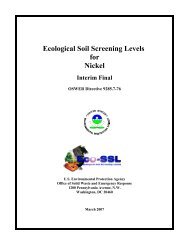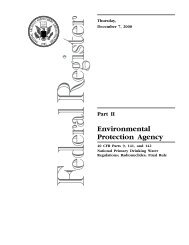Guidance for Conducting Risk Assessments and Related Risk ...
Guidance for Conducting Risk Assessments and Related Risk ...
Guidance for Conducting Risk Assessments and Related Risk ...
You also want an ePaper? Increase the reach of your titles
YUMPU automatically turns print PDFs into web optimized ePapers that Google loves.
Streamlined risk evaluations can be used to justify a removal action <strong>and</strong> to identify current or potential<br />
exposures that should be prevented. It is important to remember that the level of complexity of a<br />
streamlined risk evaluation is based on the action to be undertaken <strong>and</strong> may in some cases require as<br />
much ef<strong>for</strong>t as a conventional baseline risk assessment.<br />
<strong>Risk</strong> guidance <strong>for</strong> D&D facilities was developed by DOE-ORO with the assumption that the<br />
facilities may need to be evaluated with the same rigor as DOE-ORO hazardous waste sites. There<strong>for</strong>e,<br />
the guidance provides methods to estimate:<br />
• the potential source terms associated with past <strong>and</strong>/or on-going releases from available historic,<br />
operational, <strong>and</strong> environmental data;<br />
• the probability <strong>and</strong> magnitude of releases due to catastrophic events (e.g., tornadoes); <strong>and</strong><br />
• the potential magnitude of releases due to deterioration of building materials with time.<br />
These estimates can be used, in turn, to complete screening risk evaluations, baseline risk assessments,<br />
<strong>and</strong> alternatives evaluations.<br />
The screening risk evaluation guidance was designed to produce relative risk scores to support D&D<br />
action, prioritization, <strong>and</strong> decision-making. The baseline risk assessment guidance was developed using<br />
parts A through C of <strong>Risk</strong> Assessment <strong>Guidance</strong> <strong>for</strong> Superfund (EPA 1989, 1991a, 1991b) to provide a<br />
consistent approach <strong>for</strong> projecting the potential <strong>for</strong> adverse effects to human health <strong>and</strong> the environment<br />
from D&D facilities. These unique documents provide methods to estimate source terms from historical<br />
<strong>and</strong> operational in<strong>for</strong>mation regarding the nature <strong>and</strong> volume of materials contained within the<br />
infrastructure (e.g., piping, insulation, drains, etc.). The D&D risk assessment guidance documents are<br />
referenced in Table 4, <strong>and</strong> a brief abstract <strong>for</strong> each is provided in Appendix A.<br />
Table 4. D&D risk assessment guidance documents<br />
Baseline <strong>Risk</strong> Assessment <strong>Guidance</strong> <strong>for</strong> D&D Facilities, K/ER-153/R1, Oak Ridge National Laboratory, Oak Ridge,<br />
Tennessee. (LMES 1995a)<br />
D&D Alternatives <strong>Risk</strong> Assessment <strong>Guidance</strong>, Oak Ridge National Laboratory, Oak Ridge, Tennessee. DRAFT<br />
(LMES 1996a)<br />
D&D Screening <strong>Risk</strong> Evaluation <strong>Guidance</strong>, ES/ER/TM-165, Oak Ridge National Laboratory, Oak Ridge,<br />
Tennessee. (LMES 1995b)<br />
The methods outlined in the D&D guidance documents may be used to support a streamlined risk<br />
evaluation. The D&D guidance documents provide in<strong>for</strong>mation <strong>for</strong> data evaluation, source term<br />
estimation, exposure assessment, catastrophic failure, <strong>and</strong> other related risk activities (i.e., prioritization,<br />
evaluation of alternatives, etc.). This in<strong>for</strong>mation helps ensure that risk assessments are consistent with<br />
accepted regulatory guidelines <strong>and</strong> technically defensible. The guidance is not all encompassing,<br />
however, as new risk assessment methods are being developed in the D&D area. The <strong>Risk</strong> Assessment<br />
Technical Lead (RATL) <strong>for</strong> a particular project should consult with the project manager <strong>and</strong> the <strong>Risk</strong><br />
Advisory Board (RAB) as needed to ensure that:<br />
• the most innovative <strong>and</strong> cost effective methods of assessment are used <strong>for</strong> D&D risk evaluations,<br />
• the new methods are consistent with existing regulatory guidance, <strong>and</strong><br />
• the assessment will meet the needs <strong>and</strong> expectations of the DOE-ORO EM Program.<br />
18


